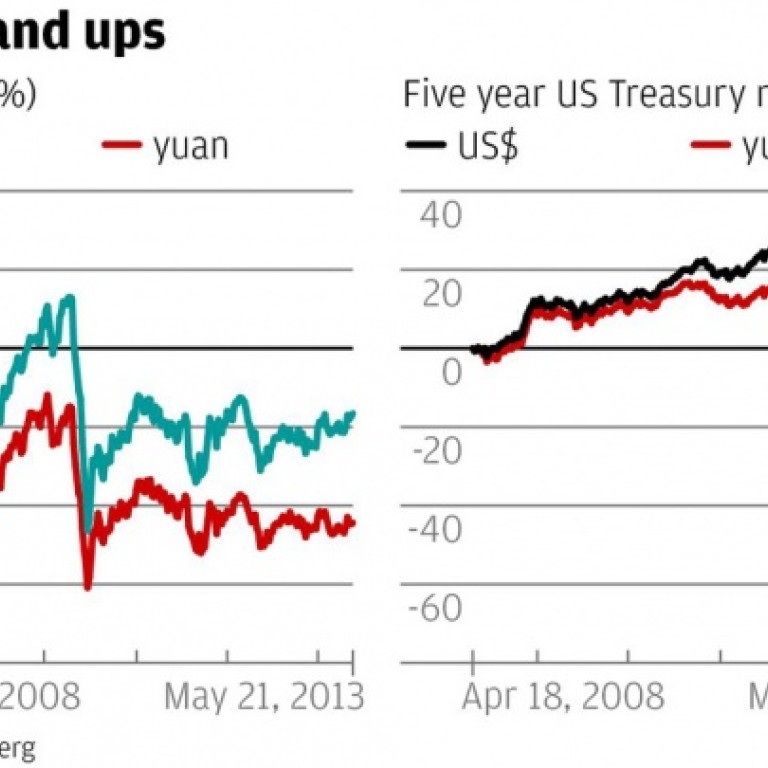
Attempts to diversify China's reserves have been a disaster
Plain old US Treasuries would have been a respectable earner for forex agency, before its stock pickers over-reached with some big-ticket flops
American asset prices have been enjoying a ripsnorting rally lately.
Over the last six months the S&P500 stock index has climbed 20 per cent. Alternative assets like hedge funds are generating decent returns. Even house prices are up.
With liquidity plentiful, and valuations modest by historical standards, most investors expect the bull run to continue.
But for market watchers who like to keep an eye out for contrarian indicators, there is one incidental sign that the current trend may soon be nearing its peak.
According to yesterday's edition of , China's State Administration of Foreign Exchange has opened a New York office to diversify its investments into unconventional asset classes.
For SAFE, the central bank body charged with managing China's US$3.4 trillion pile of foreign currency reserves, unconventional means anything but US Treasury or government agency debt, which in the past have made up at least half of its total foreign currency holdings. Now it is looking to spice up its US portfolio with the addition of stocks, private equity, real estate and other high-octane asset classes.
Attempts to diversify China's foreign reserves away from US Treasuries are nothing new. As long ago as 1997 the central bank set up the SAFE Investment Company, or SIC, with an office in Hong Kong and US$20 billion to invest.
But in recent years SAFE has stepped up its diversification programme, partly in response to the establishment in 2007 of the rival China Investment Corporation.
According to Friedrich Wu, a professor of economics at Singapore's Nanyang Technological University who has made a close study of China's sovereign wealth funds, SIC now manages US$347 billion in assets, almost as much as CIC's US$468 billion.
Unfortunately, SIC's track record as an international investor is less than impressive.
In the run-up to the 2008 financial crisis, the company made a number of large foreign investments. The most high profile were a US$2 billion, 1 per cent stake in British oil giant BP and a US$3 billion, 2 per cent stake in French oil major Total.
At the time this column warned that the investments were likely to underperform. Even so, it is remarkable just how poorly they have done. Since April 2008, when SIC acquired its stakes, BP shares have slumped 16 per cent, while Total is down 20 per cent.
SIC didn't confine itself to oil companies. It also invested heavily in Britain's financial sector, with sizable stakes in Royal Bank of Scotland and Barclays, as well as the insurance company Aviva. Barclays is down 27 per cent, and RBS a massive 88 per cent. Aviva shares have fallen 46 per cent.
Those losses are all in local currency terms. But for a yuan-based investor, the losses are much bigger. Over the same period the euro has fallen 29 per cent against the yuan, while the pound has dropped 33 per cent. As a result, in yuan terms both BP and Total have fallen 43 per cent, while SIC's stake in RBS has lost 92 per cent of its value.
Those losses are painful enough. But to add insult to injury, SAFE would have been better off leaving the money where it was originally in US Treasury debt. Since April 2008, five-year US Treasury notes have delivered a total return to US dollar investors of 29 per cent.
Factor in the appreciation of the Chinese currency, and in yuan terms that return shrinks to 13 per cent. Even so, US Treasuries have generated a positive return, which is more than can be said for SIC's high-profile equity investments.
Given that they are now opening a New York investment office, it appears SIC's managers are undaunted by their losses. But if the company's track record of buying assets just before they plunge in value is any guide, it is hard to feel any confidence that the US rally will go on much longer.

